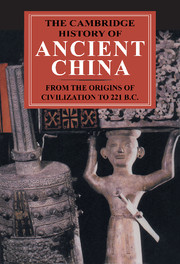Book contents
- Frontmatter
- Introduction
- 1 China on the Eve of the Historical Period
- 2 Language and Writing
- 3 Shang Archaeology
- 4 The Shang: China’s First Historical Dynasty
- 5 Western Zhou History
- 6 Western Zhou Archaeology
- 7 The Waning of the Bronze Age: Material Culture and Social Developments, 770–481 B.C.
- 8 The Spring and Autumn Period
- 9 Warring States Political History
- 10 The Art and Architecture of the Warring States Period
- 11 The Classical Philosophical Writings
- 12 Warring States Natural Philosophy and Occult Thought
- 13 The Northern Frontier in Pre–Imperial China
- 14 The Heritage Left to the Empires
- Bibliography
- Index
- Map 1 Topography of China
- Map 3.1 Archaeological sites of the Early Bronze Age
- Map 6.1 Archaeological sites of the Western Zhou period
- References
13 - The Northern Frontier in Pre–Imperial China
Published online by Cambridge University Press: 28 March 2008
- Frontmatter
- Introduction
- 1 China on the Eve of the Historical Period
- 2 Language and Writing
- 3 Shang Archaeology
- 4 The Shang: China’s First Historical Dynasty
- 5 Western Zhou History
- 6 Western Zhou Archaeology
- 7 The Waning of the Bronze Age: Material Culture and Social Developments, 770–481 B.C.
- 8 The Spring and Autumn Period
- 9 Warring States Political History
- 10 The Art and Architecture of the Warring States Period
- 11 The Classical Philosophical Writings
- 12 Warring States Natural Philosophy and Occult Thought
- 13 The Northern Frontier in Pre–Imperial China
- 14 The Heritage Left to the Empires
- Bibliography
- Index
- Map 1 Topography of China
- Map 3.1 Archaeological sites of the Early Bronze Age
- Map 6.1 Archaeological sites of the Western Zhou period
- References
Summary
The northern frontier of China has long been recognized as something more than a simple line separating natural zones, political entities, or ethnic groups. This frontier has been represented as the birthplace of independent cultures and the habitat of peoples whose lifestyle, economic activities, social customs, and religious beliefs became, from the Bronze Age onward, gradually but increasingly distant from the civilization of the Central Plain. This distinct cultural region, often called the “Northern Zone” of China, comprises the interlocking desert, steppe, and forest regions from Heilong jiang and Jilin in the east to Xinjiang in the west. The frontier between China and the north has also been envisaged as a bundle of routes and avenues of communications through which peoples, ideas, goods, and faiths flowed incessantly between West and East. In economic terms, it provided the Chinese with a source of foreign goods as well as a market for domestic production.
The process by which the northern frontier acquired these qualifications was a long one. While its complexities cannot be captured in a single image, the Great Wall – this symbolic and material line that came into existence as a unified system of fortifications with the establishment of the Qin empire in 221 B.C. – can be seen as the culmination of a long process of cultural differentiation that embraces several aspects.
- Type
- Chapter
- Information
- The Cambridge History of Ancient ChinaFrom the Origins of Civilization to 221 BC, pp. 885 - 966Publisher: Cambridge University PressPrint publication year: 1999
References
- 28
- Cited by



